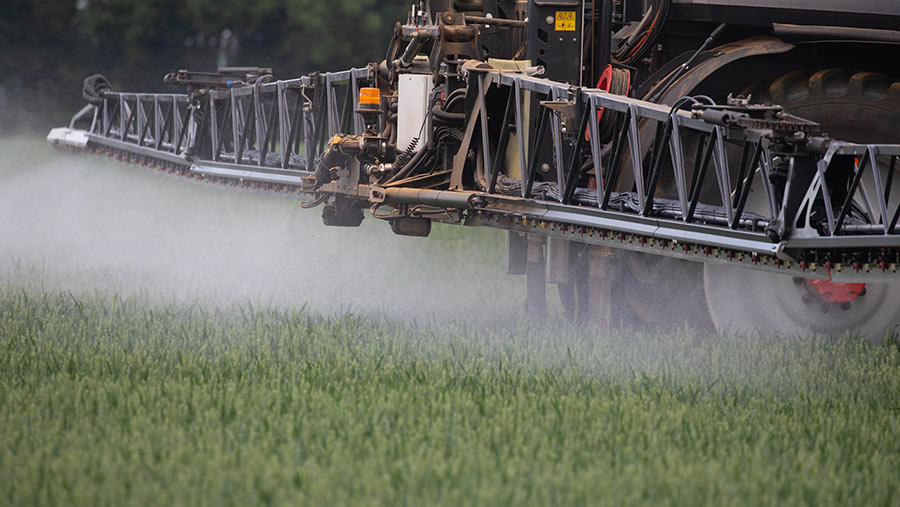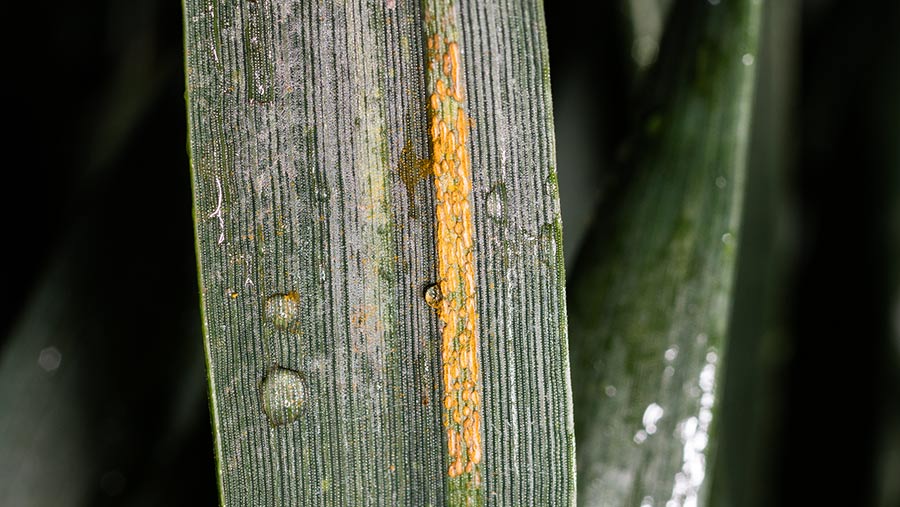Why farmers need to carefully monitor yellow rust in wheat
 © Tim Scrivener
© Tim Scrivener The surge in yellow rust is becoming a bigger challenge for agronomists and farmers.
The disease takes its name from the highly visible parallel lines of yellow-orange pustules that are produced along the leaves of adult plants.
New races of the pathogen and unexpected infections on previously resistant varieties have caused well-documented control difficulties in the field, with growers being warned to “expect the unexpected” from such a highly diverse pathogen.
As a result, the way that variety resistance ratings for yellow rust are calculated has been changed this year, with greater emphasis being given to the most recent results.
In addition, an on-line “watch list” of varieties considered to be at greatest risk and most likely to perform differently to their ratings has been published by the AHDB, giving an early in-season warning of any problems.
See also: 5 tips on using Nemathorin to control nematodes in spuds
The problem
The most severe yellow rust epidemics are usually associated with the perfect storm of very susceptible varieties, mild winters and cool moist summers, with yield losses of 40-50% being recorded where varieties do succumb.
The disease – which was known for being sporadic in the UK, occurring more often in the east of the country and in coastal areas – has been seen at much higher levels in the past couple of years.
This surge is due to the arrival of new, more aggressive races of yellow rust in the field – up to 10 were identified last year – which have been able to overcome some of the genetic resistance found in popular varieties.
Experts warn that the fluidity of the situation and the potential for further change from an increasingly diverse pathogen population mean that it is impossible to predict what will happen next.
Its diverse and dynamic nature also means that yellow rust has shown variation across sites and seasons.
As a result, popular winter wheat varieties have seen their disease resistance ratings revised, with some dropping by as much as three points.
Risk to crops
Against this background, it is essential to monitor crops and report any unexpected findings as the season develops.
As Jonathan Blake, associate director at Adas points out, yellow rust continues to be a complex and moving scenario, so there will be implications for its management and control.
“The yellow rust situation in the UK is very dynamic,” he says.
“The variety ratings are as accurate as they can be, but don’t assume anything. It takes time to detect and confirm new races, which is why the information we have can seem to be behind what’s happening in the field.”
These variety ratings are now weighted. Although they are still based on a three-year data set, the most recent year’s results have the largest influence.
Introduced for 2021, they are being combined with an advanced warning system, to give growers greater guidance.
How it spreads
Yellow rust requires living green plant material to survive. It can overwinter as dormant mycelium or active sporulating lesions, either on volunteers, late green tillers or early sown winter wheat crops.
It then appears as distinct “foci” in crops and can be spread over long distances by the wind.
Once within plant tissue, yellow rust can survive the coldest of UK winters.
As it warms up in the spring, the fungus starts to grow and produces active sporulating lesions, with the ideal growing conditions being at temperatures of between 8-15C.
Cool, damp weather is conducive to its development.
In perfect conditions, the complete cycle from infection to the production of new spores can take as little as seven days.
This means the disease cycle can be repeated many times in one season.
The fungus may be inhibited by temperatures over 20C, although some experts believe that the new strains of yellow rust are tolerant to a wider temperature range.
Yellow rust management
Contrary to previous thinking, early sown crops are not at greatest risk from yellow rust.
“We’ve been able to show that later-sown crops have more yellow rust, which can be explained by the relationship between the pathogen and plant age,” says Mr Blake.
The number of winter frosts below -5C also has a bearing on its development in the spring, as yellow rust clings to the lower leaves in the winter. If these are lost to the cold, so too is the infection.
In contrast, mild winters increase the likelihood of the disease surviving, leading to early infection in the spring. While a cold winter helps to delay the epidemic, it won’t stop it.
Despite the arrival of new races, varietal resistance can still be a useful option in limiting the incidence and spread of yellow rust, forming part of an integrated approach.
Resistance is measured at the seedling stages and also at the adult plant stages – varieties can be susceptible in the early parts of their life, but resistant at the adult stage.
The Recommended List ratings reflect adult plant resistance.
“It’s the adult stage that really counts, even though it doesn’t kick in until later in the growing season. The timing of this varies between varieties, but has always happened by growth stage 39,” says Mr Blake.
In order to alert growers as soon as possible to changes in varietal resistance, the team at the UK Cereal Pathogen Virulence Survey updates the Recommended List information annually.
Samples of yellow rust from throughout the season are analysed, building a picture of the races that are established in the UK.
New races may occur when there is over-reliance on a single resistance gene; they may also arrive into a new area through weather, travel or trade.
What makes the new discoveries different to the older, established races is that they seem to produce more spores and cycle more rapidly when they are in wheat crops.
“They certainly behave more aggressively in the field, producing serious yellow rust. As a result, they push the epidemic more quickly.”

Later-sown crops can have more yellow rust © Blackthorn Arable
Fungicides
There is a good choice of fungicides for controlling yellow rust, which, unlike septoria, includes the strobilurins.
When planning their strategy, cereal growers should aim to be one step ahead of the disease, rather than having to react to it.
That means the early spray timings are important if the disease is already present, advises Bill Clark, technical director at Niab Tag,.
He puts the emphasis on the T0 and T1 sprays, so that it doesn’t get the chance to get away.
Niab trials have confirmed this timing focus, with a 2t/ha drop in yield being recorded where either the T0 or both the T0 and T1 sprays were omitted, before a “hefty” T2 was applied.
Unfortunately, because having a good resistance rating is no indicator that a variety will remain clean, there is a need for vigilance as the spring gets underway.
Varieties, such as Skyfall, which previously didn’t carry the disease can now be affected. Other varieties considered to be susceptible include Zyatt, Kerrin, Kinetic and Wolverine.
“Don’t assume that the winter will kill yellow rust. Unless it’s cold enough to kill the leaf the rust is on, it simply won’t,” he says.
He describes T0 and T1 as the building blocks, with a key T0 decision being whether yellow rust needs prioritising.
There are choices with fungicides. A strobilurin will dry out any rust that’s present and give two to three weeks’ protection, while an azole is preferred if the yellow rust is established.
For Mr Blake, the decision on product choice for yellow rust at the early stages is clear.
“The best performing azoles on rust are epoxiconazole, cyproconazole and tebuconazole, which all offer curative activity, so they should be the first choice where yellow rust is active.
“The strobilurins are more protective than curative, but are behind the azoles in terms of performance. They have a place where protection is required.”
The SDHIs will add to yellow rust control, but are not enough on their own, adds Mr Blake. “They’re less effective on yellow rust than they are on brown rust.”
By the time you get to the T2 spray, there will be yellow rust activity provided by an SDHI/azole combination, which is a fairly standard treatment at that stage, he notes.
“What’s important is that you are using a robust rate of azoles, with 80% being the minimum. This, along with good spray timing, is essential.”
Fungicide results 2020
The AHDB fungicide dose response work conducted in 2020 showed small differences between azole, SDHI and strobilurin products for yellow rust control.
With both straights and mixtures tested, there was good activity from all of the SDHI/azole mixes, giving 50-60% control from a single application, with Elatus Era (benzovindiflupyr + prothioconazole) just edging ahead of Ascra (bixafen + fluopyram + prothioconazole) and Revystar (fluxapyroxad + mefentrifluconazole).
Epoxiconazole has always been the benchmark for yellow rust control and continues to perform well, although 2021 will be its last season of use.

